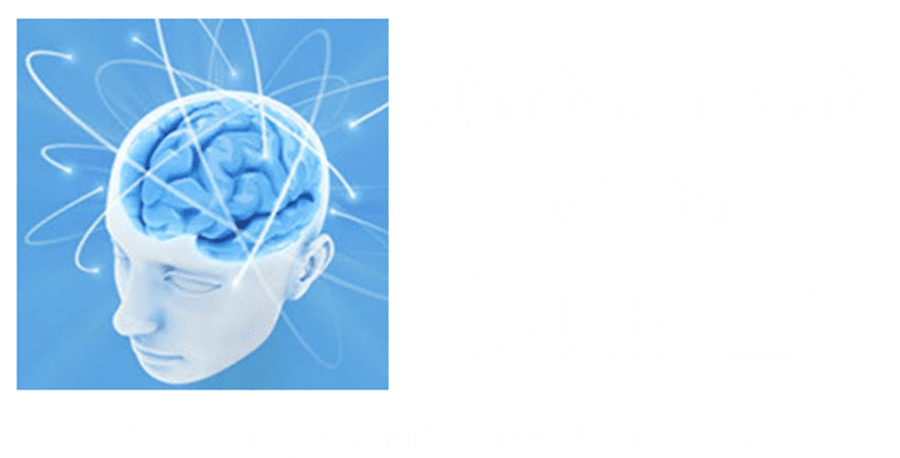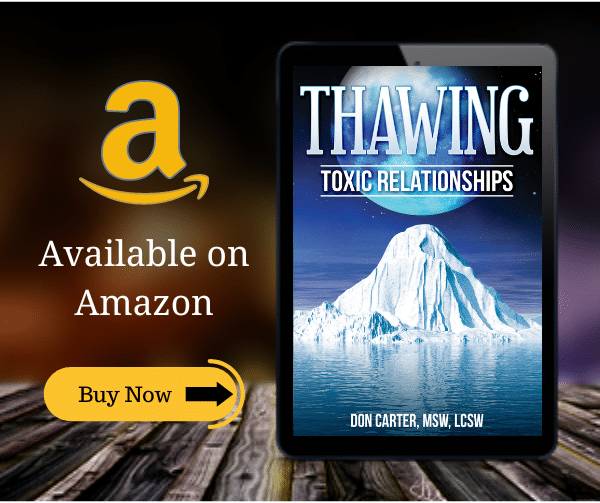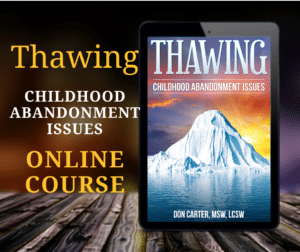
What is a Healthy Relationship?
What is a healthy relationship? Is it really something we just fall into if we are lucky? Some people imply that they think so when they say things like “I am just unlucky in love.” The truth is that we have to put some effort into creating a fulfilling relationship. More to the point, since it really does “take two”, we need to Co-Create a healthy relationship. Is it worth all that effort? How important is it anyway?
Mini-Course Preview: What is a Healthy Relationship?
Thawing Toxic Relationships Course
Givers and Takers
Dr. William Glasser, the creator of Reality Therapy, identifies the healthy relationship as the foundation for good emotional and mental health. For a fulfilling relationship we need to:

- Give Love
- Receive Love
- Feel worthwhile to self
- Feel worthwhile to others
Externalizers or”Takers” are all-about-themselves so they are good at receiving love and feel worthwhile to self… but not so good at giving love or feeling worthwhile to others.
Internalizers or “Givers” are all-about-others so they are good at giving love and feel worthwhile to others… but not so good at receiving love or feeling worthwhile to themselves.
Most of us are aware that Givers and Takers seem to find each other… This is another example of the subconscious synchronization of compatible neural networks – such as those between Codependents & Alcoholics, Distancers & Pursuers, or Victims & Rescuers.
In a healthy intimate relationship both parties are giving and receiving love… and as a result, feel worthwhile to self and the other. They take responsibility for co-creating their relationship.
For example, if I refuse to open up and share my true feelings with you then we cannot have intimate communication. But if I do choose to allow myself to be open and vulnerable we can enjoy healthy intimacy – provided your response reinforces my choice to share how I feel with you. If you – on the other hand – repeatedly respond in a hurtful way to my attempts to be open then I soon decide its not okay to be open.
In other words – we co-create our healthy relationship patterns through our genuine attempts to communicate and our partner’s supportive and authentic responses to those attempts. So what does a healthy relationship look like? See “Traits of a Healthy Relationship” in the next section. For “Stages of a healthy relationship” click here.
Or you may want to explore the Twenty Signs of Marriage Problems and Healing Marriage Problems.
Traits of a Healthy Relationship
The healthy relationship does not just happen – it’s like a plant: It needs to be nourished, watered, and put out in the sunshine. If the plant is not cared for properly it will begin to show signs of stress… wilting, turning yellow – eventually it dies. The healthy relationship goes through specific developmental stages and has identifiable traits…
Traits of a Healthy Relationship:
Love – The two toughest questions of existence – “What is life?” and “What is love?” I do not claim to know the answers to these questions because I feel it’s something highly subjective and personal – We all have to answer these questions for ourselves and we all have our own constantly evolving cognitive map for the terms. Whatever “true love” means to you is going to guide all of your actions, reactions, and decisions in the arena of relationship because it is so closely tied to the pain & pleasure continuum. There is nothing quite like “getting it right” in a healthy relationship and nothing quite like “getting it wrong” and losing at love. To me, sports is the closest I can get to something similar… I’m old enough to remember the old ABC Wide World of Sports tagline – “…the thrill of victory and the agony of defeat!”. Whatever love means to YOU… it must be there for you to stay motivated to last the entire season and win the “Superbowl”.
Me? – I think love is a verb… an action word. It’s not a “thing” that exists between us. It’s something we demonstrate over and over again in our actions and reactions. Love is a behavior that helps us co-create a loving, healthy relationship”.Like the term “relationship”… “love” is a nominalization (a verb turned into a noun). We must turn both terms back into action words in order to “get it right.” The action word for a relationship is to “relate” – When we step back and ask “How is our relationship going?”… it’s the wrong question.We need to get specific and ask questions like:
- “Who is doing most of the relating?”
- “Who is relating what to whom?”
- “Am I relating what I want to relate to my partner?”
Many times people miss the expressions of love by their partners because they are looking for the wrong things…Some expect to hear frequent “I Love Yous”… But their partner’s may have learned to express love by some other method such as:
- Working hard to make a comfortable living
- Giving gifts
- Spending time together
- affectionate touch
- Doing things for their partner
It is important to be able to ask for what you need… In fact, the hallmark of a dysfunctional relationship is that it is NOT okay to ask directly for what you need. Perhaps you have repeatedly asked your partner for more physical affection…they may try for a few days but then things “go back to normal”. It’s usually because your partner does not have that particular behavior built into his/her neural network for love, also known as their… Love Map.
In this case, your partner must “practice” by consciously making an effort to give you what you need. At first, it will feel solicited (because it is) but within a few weeks can become automatic and unsolicited… a part of your synchronized map for how you do love as a couple. It’s much easier to run on auto-pilot and go with our subconscious programming than it is to develop new programming with conscious effort… All those New Years’ resolutions that we fail to keep are examples of this. However, for something as important as your healthy relationship it’s wise to invest the effort in updating your Love Map… maybe just one thing at a time, but do it whenever possible. There is a presupposition in NLP that states: “You cannot NOT communicate”. It means that your lack of relating – is relating something to your partner. The remainder of this list are some traits worth relating to each other that will help you “get it right” – provided you really want to invest in and co-create a healthy relationship.
Separateness and Connectedness – Any expert on healthy relationships will spend a lot of time assessing the separateness and connectedness of a couple who comes to them for help. The ability to maintain a solid sense-of-self is critical to being able to co-create a healthy relationship. Likewise, the ability to bond with another person is a requirement for true intimacy. To get an idea of this concept; bring both of your hands together touching only at the fingertips and thumbs… Here you see two parts creating one whole (connectedness)… However, you can also see where one begins and the other ends (separateness). Now…interlace your fingers as if you are folding your hands. This is all connectedness and no separateness. A couple of family therapy terms for this are “fusion” or “enmeshment” – two people have become so tangled up with each other emotionally that it’s hard to tell where one ends and the other begins – They have lost their healthy boundary.
Enmeshment may look equal but it is not…one person gets “swallowed-up” or engulfed by the other losing their autonomy and sense-of-self. An Externalizer usually does the swallowing and the Internalizer usually gets swallowed-up. If this is a theme in your relationships then it is likely that you became emotionally enmeshed with one of your parents which kept you from being able to fully separate or gain a sense of autonomy. “Being swallowed-up” is a reenactment, or repetition-compulsion of that early enmeshment and “doing the swallowing” is usually a reaction-formation to the pain of that early experience. A reaction-formation is an external over-compensation for an internal fear of the opposite. For example, an excessive need for control is often an over-compensation for a fear of being controlled. If you will now separate your hands entirely and keep them six to eight inches apart you can see all separateness with no connection… family therapists call this a “disengaged” relationship. The wide boundary between them is created and maintained by distancing behaviors.
Distancing in a relationship is also related to a fear of enmeshment or engulfment – a fear of being “swallowed up” and losing the boundary between self and other. Kids who experienced too much distance in their “source relationships” (Parents) develop a fear of abandonment… they tend to choose distances who fear being engulfed. The distancing of their partner triggers their fear of abandonment causing a compulsion to pursue… which causes more distancing by their partner – a repetition-compulsion or “reenactment of the family dance” they were programmed to act-out. For more on the dynamics of distance & pursuit check out Don’s Thawing Toxic Relationships Online Course. A people in a healthy relationship relate to each other in a way that respects the partnership they have formed while also respecting the individuality of each other. This ability to balance separateness with connectedness allows Mutuality to develop…
Mutuality – Mutuality is a blend of acceptance and equality were partners in a healthy relationship…
- accept each other as they are
- make sure each their of needs are given equal priority
- are willing to make sacrifices for win-win scenarios
- encourage and support each other in pursuit of individual goals and dreams, even if that means less time together and, in some cases, even if it means letting them go by mutually ending or suspending the relationship.
Intimacy – True intimacy is the ability to share who you really are with another person… This presupposes that you have a partner who is also willing and able to share who they really are with you. If you’ve read the “Iceberg” then you know about the Invented-Self, the False-Self, and the True-Self. Sharing your True-Self demands that you have access to it.T hose who have been affected by the woundedness of others may not know who they really are – Some may even have Adult-Child Syndrome, Codependency, an Addiction, Depression, or some other chronic neural network that limits or impairs their ability to share who they really are. If this is true in your case (as it is with most of us) then your healthy relationship can only come with a plan for healing your own woundedness as a first step. If you already have self-awareness (i.e. know your issues and are doing something about them) then you may be ready for the work of co-creating your future.
Even in the best of circumstances laying the groundwork for a healthy relationship is hard work… but with a great payoff! A word about sex – Healthy couples have a great sex life because they have discovered that sex is the “gravy on top” and that the “meat and potatoes” of their partnership are the intimacy that comes from the emotional connection that they share. Some people place so much emphasis on sex that they don’t feel inclined to do the work of building a healthy relationship. While sex is an intimate act and as close as two people can physically get to one another… it’s just not the same without having the emotional connection that comes from true intimacy – sharing who you really are. This is frequently why many relationships fail… you cannot survive for long on gravy alone. I’ll go out on another limb here and say that you have never experienced great sex if you have not first connected fully on an emotional level.
Response-able Partners – Response-able partners accept that they have the ability-to-respond in any way they choose to any situation in their life. They refuse to put on the mantle of Victimhood which is handed out so easily in our culture. They may have irrational thoughts, limiting beliefs, emotional wounds, and other issues in their life that hold them back – but they are doing something about it. They know that they can change and are actively involved in personal growth. For more on this check out this information on Response-Ability.
Trust & Safety – Trust & Safety cannot be separated. They are the byproducts of practicing the ideas and behaviors list here. Have you ever tried to pull a blanket off of someone who’s cold? They just hold on that much tighter… If you want them to take the blanket off, then turn up the emotional thermostat to “warm and safe” and they will take it off themselves. (Melody Beattie – The Language of Letting Go P.249)
Adaptability – People in a healthy relationship are flexible and can adapt to the changing needs of their partner. They value differentness as much as they do sameness. They can agree to disagree without it affecting the way they relate to each other.
Commitment – All of the above takes supreme effort and commitment. The first item on this list (Love) will provide the motivation and energy to stick with this last item – a strong commitment to tighten the “nuts and bolts” in between.




